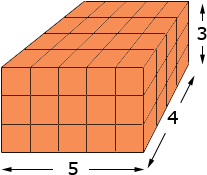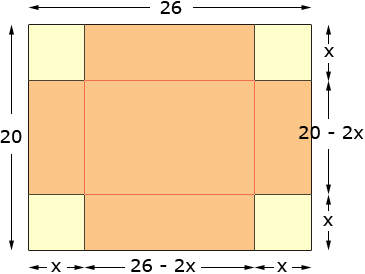 |
 |
|
I am an education student in a class that teaches us how understand how math works well enough to be able to teach it when it comes up in our context area(not math). We had a question on volume.
|
|
Hi Elizabeth, Imagine that you have a box that is 5 centimeters long, 4 centimeters wide and 3 centimeters high. I want to completely fill it with cubes that are 1 centimeter in each dimension. I can start by placing 4 row of 5 cubes each on the bottom of the box using 4
I can add two more layers since the box is 3 centimeters high, and hence I use Your second question about forming the largest volume box possible involves a use of calculus. Let's look at your 26 cm by 20 cm rectangle and imagine that we cut out corners as you described, and then formed a box. I want to see what happens for various sized square cut-outs so I am not going to use a specific size for the cut-outs, rather I will say that the cut-out is x cm by x cm.
As you can see in the diagram, when you cut out the corners and fold up the sides to make a box its dimensions are 26 - 2x cm long, 20 - 2x cm wide and x cm high. Thus its volume is
I want to call this expression V(x), V for volume and x for the sides of the square removed. Thus, simplifying I get
This is the expression you calculated in your experiments (probably not in this form). What you found was that when x was small (1 cm) the volume was quite small and the volume increased for x = 2 cm then 3 cm and 4 cm, but when x became 5 cm the volume started to decrease. What I want to do is find the exact value of x where this change from increasing to decreasing occurs. This is where calculus enters the process. A function called the derivative of V(x) (designated V'(x)) measures the rate at which V(x) changes as x changes. V'(x) is positive for small values of x (the volume is increasing as x changes from 1 to 2 etc.) and V'(x) is negative for larger values of x (the volume is decreasing as x changes from 4 to 5 etc.) I want to find where V'(x) is zero, that is where it changes from being positive to being negative. Using calculus I find that
so I want to solve
I solved this with the general quadratic and found x = 11.58 cm and x = 3.74 cm. If you look back at the diagram you will see that x = 11.58 cm is impossible, so this answer of the mathematical problem is not a valid answer to the physical problem of cutting out square corners. The answer I am looking for is x = 3.74 cm. Why did you get x = 4 cm and I got x = 3.74 cm? My technique allows for fractions and I expect that you only used integers. If you go back to your calculations and find the volume when you remove a 3.74cm Penny |
 |
 |
 |

